What Is the Meaning of the Check Engine Light Symbol?
The check engine light symbol on your dashboard signals potential issues with your vehicle's engine or emissions system. Common causes include malfunctioning oxygen sensors, a loose gas cap, failing catalytic converters, and issues with ignition coils or spark plugs.
Diagnosing the problem typically involves using an OBD-II scanner to retrieve diagnostic trouble codes (DTCs), supplemented by visual inspections and functional tests. The severity ranges from low-priority issues like a loose gas cap to critical problems requiring immediate attention.
For a safe and efficient driving experience, continue exploring how to address and prevent these issues effectively.
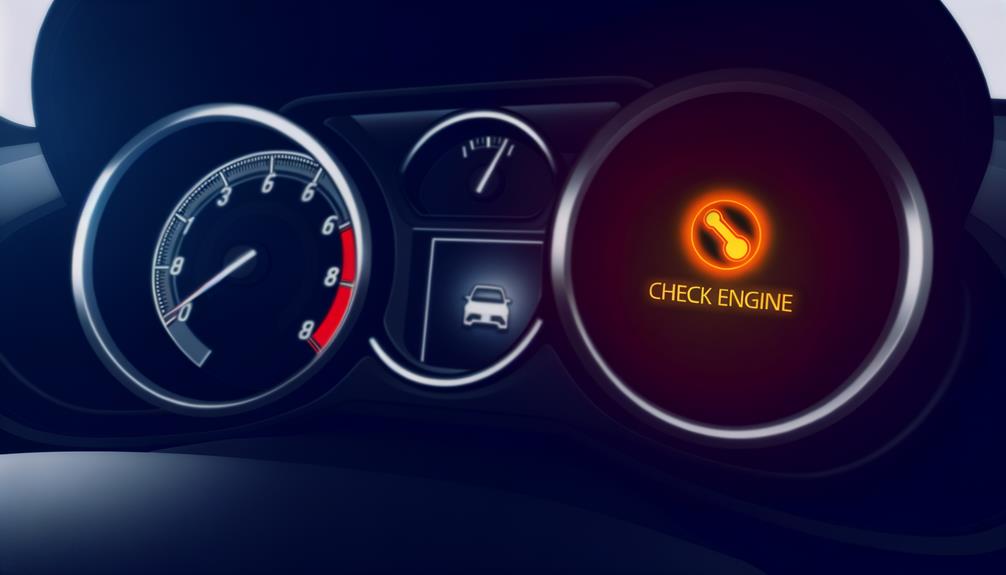
Key Takeaways
- The check engine light indicates potential issues that need attention.
- OBD-II scans retrieve diagnostic trouble codes to identify specific problems.
- A flashing light signifies severe conditions like engine misfire, requiring immediate attention.
- Common causes include a malfunctioning oxygen sensor, loose gas cap, or failing catalytic converter.
- Addressing issues promptly can prevent engine damage and enhance vehicle longevity.
Common Causes
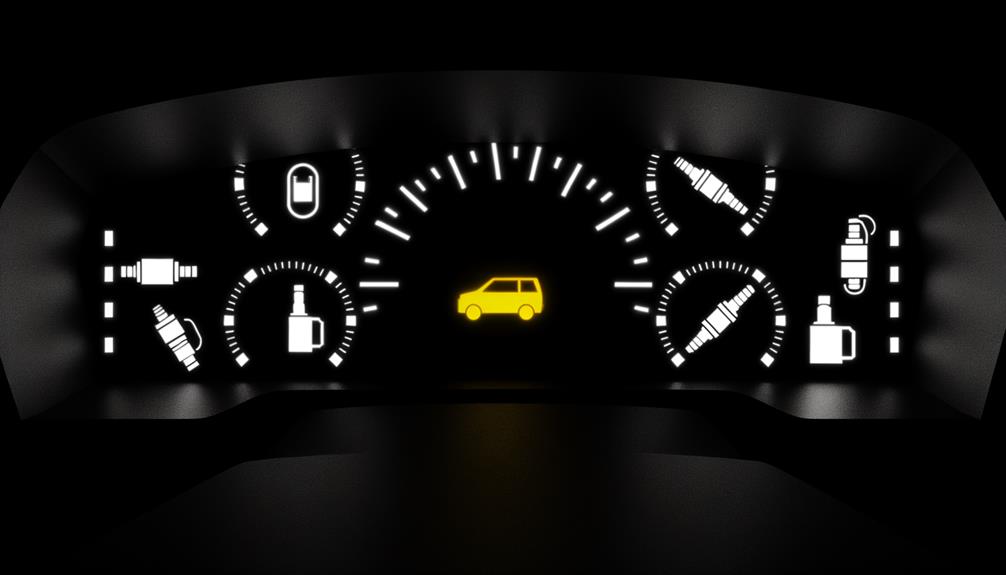
One of the most common causes of a check engine light illumination is a malfunctioning oxygen sensor, which can greatly impact engine performance and fuel efficiency. The oxygen sensor measures the amount of unburned oxygen in the exhaust system, providing critical data to the engine control unit (ECU) to optimize the air-fuel mixture.
When the sensor fails, the ECU may receive incorrect readings, leading to inefficient combustion, increased emissions, and reduced fuel economy. Other frequent culprits include a loose or damaged gas cap, which can disrupt the fuel system's pressure, and a failing catalytic converter, essential for reducing harmful emissions.
Additionally, issues with ignition coils, spark plugs, and mass airflow sensors are notable contributors to check engine light activations.
Diagnosing the Issue
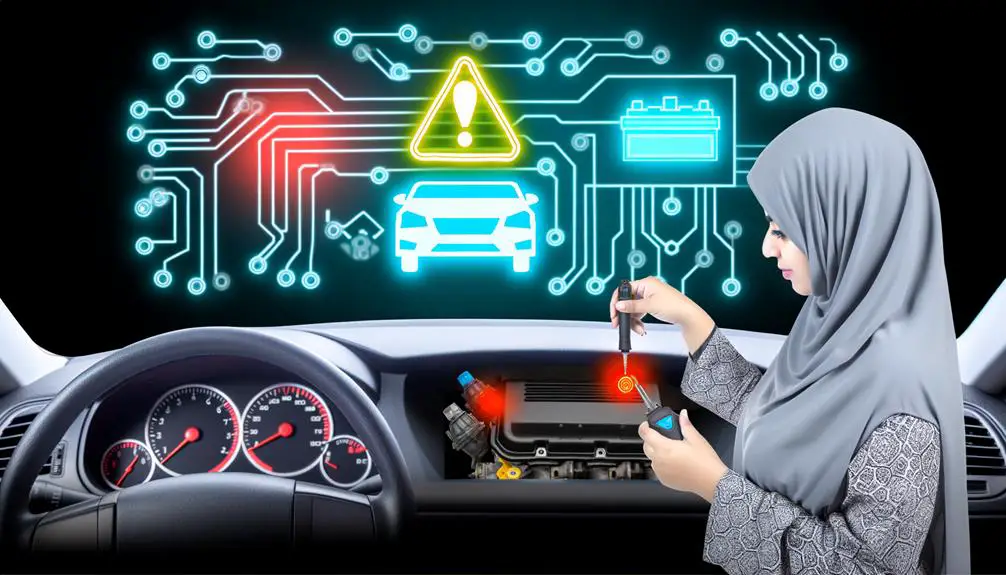
To accurately diagnose the issue causing the check engine light to illuminate, it is vital to utilize an OBD-II scanner to retrieve the specific diagnostic trouble codes (DTCs) stored in the vehicle's engine control unit (ECU). These DTCs provide a standardized method for identifying malfunctions within the vehicle's systems.
Once retrieved, each code must be cross-referenced with the manufacturer's service manual to interpret its meaning precisely. This process may indicate issues ranging from minor sensor malfunctions to more severe engine or transmission problems.
Additionally, it is important to take into account the vehicle's operational history and any recent changes to its performance. Thorough diagnosis often involves visual inspections and functional tests to confirm the root cause and avoid misdiagnosis.
Severity Levels
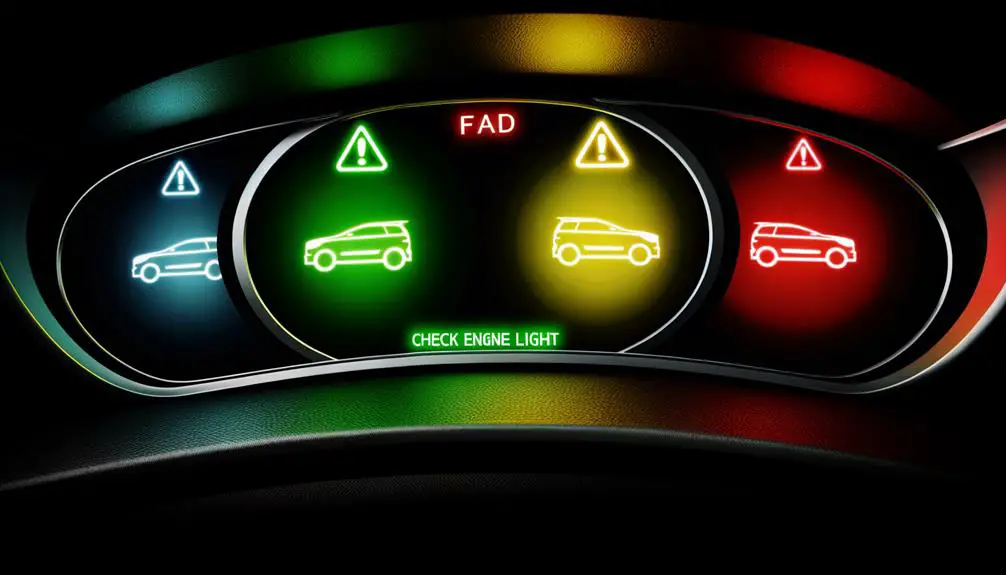
Understanding the seriousness levels associated with the check engine light is essential for determining the appropriate response. These levels can be categorized into immediate attention required, moderate urgency, and low priority, each indicating the gravity of the underlying issue.
Addressing these levels promptly can prevent further damage and guarantee vehicle safety.
Immediate Attention Required
When the check engine light illuminates, it is imperative to assess the severity levels to determine whether immediate attention is required.
A solid, steady light often indicates a significant issue that necessitates prompt diagnostic evaluation. However, a flashing check engine light is more critical, signifying severe conditions such as engine misfire, which can lead to catalytic converter damage if ignored. Immediate cessation of vehicle operation and professional mechanic intervention are advised.
Failure to address these urgent signals can result in extensive engine damage, increased repair costs, and potential safety hazards. Utilizing an OBD-II scanner can provide specific diagnostic trouble codes, aiding in promptly identifying the malfunction's nature and required corrective actions.
Moderate Urgency
While immediate attention is crucial for certain check engine light signals, other instances indicate moderate urgency where the issue may not be as severe but still requires timely diagnostic and repair efforts.
These situations often involve components that, if left unaddressed, could lead to more significant problems. Common scenarios of moderate urgency include faulty oxygen sensors, minor exhaust leaks, or issues with the vehicle's evaporative emission control system.
Although the vehicle may remain operable, delayed attention can result in decreased fuel efficiency, elevated emissions, and potential damage to the catalytic converter. It is advisable to schedule a diagnostic check as soon as possible to prevent further complications and maintain the vehicle's efficient and safe operation.
Low Priority
In cases categorized as low priority, the check engine light typically signals minor issues that do not immediately impact the vehicle's performance or safety but should still be addressed to maintain peak functionality. Such issues may include a loose gas cap, minor exhaust leaks, or a faulty oxygen sensor. Addressing these matters promptly can prevent potential escalation into more severe problems, thereby ensuring the vehicle operates efficiently.
| Issue | Description | Recommended Action |
|---|---|---|
| Loose Gas Cap | Cap not sealing properly | Tighten or replace gas cap |
| Minor Exhaust Leak | Small holes or cracks in exhaust | Inspect and repair leak |
| Faulty Oxygen Sensor | Sensor malfunctioning slightly | Replace oxygen sensor |
Regular maintenance and early detection are key to long-term vehicular health.
DIY Fixes
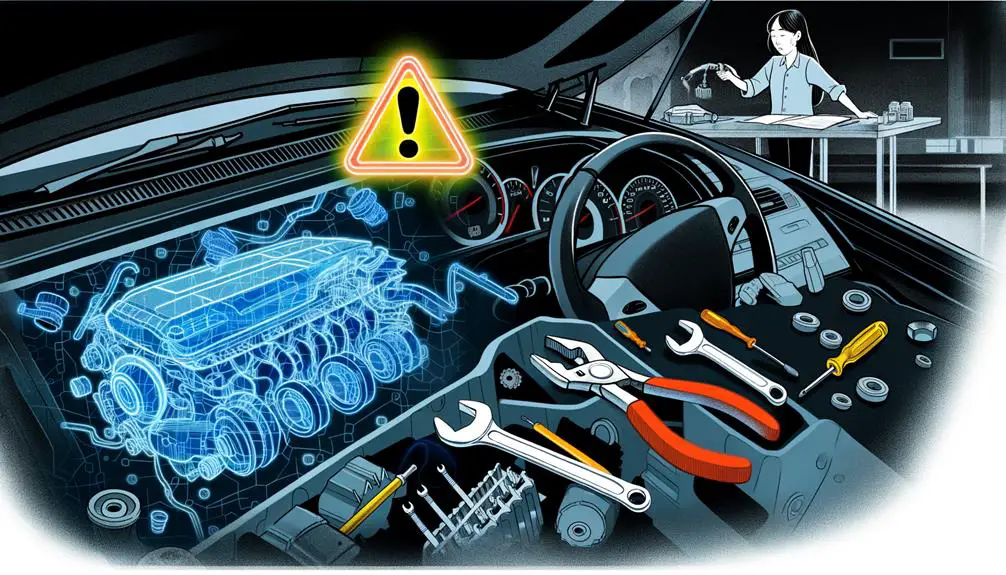
Many car owners can address common issues that trigger the check engine light with a few straightforward DIY fixes.
First, make sure the gas cap is securely tightened; a loose gas cap can cause the light to illuminate.
Next, check and replace faulty spark plugs or spark plug wires, which may lead to engine misfires.
Additionally, inspect the air filter, as a clogged filter can affect engine performance.
Utilizing an OBD-II scanner can help identify specific error codes, guiding further troubleshooting.
Replacement of a malfunctioning oxygen sensor or mass airflow sensor can also be managed by those comfortable with basic engine components.
Always refer to the vehicle's manual for step-by-step instructions and safety guidelines to guarantee proper handling.
When to Seek Help

In cases where the check engine light remains illuminated despite initial troubleshooting efforts, professional diagnosis is highly recommended.
Additionally, if the vehicle exhibits unusual behavior such as diminished performance, strange noises, or erratic operation, seeking expert assistance becomes crucial.
Prompt professional intervention can prevent further damage and guarantee the vehicle's peak functionality and safety.
Persistent Warning Signal
A persistent check engine light typically indicates a recurring issue that warrants immediate diagnostic evaluation by a professional technician.
This signal suggests that your vehicle's onboard diagnostic system has detected a malfunction within the engine, emissions system, or other critical components. Ignoring the warning can lead to more severe damage and costly repairs.
Professional technicians utilize specialized diagnostic tools to read error codes, pinpointing the exact issue. Common causes include faulty oxygen sensors, catalytic converter issues, or malfunctioning mass airflow sensors.
Accurate diagnosis is essential for effective repairs, ensuring the vehicle operates efficiently and safely. Immediate attention to a persistent check engine light can prevent further mechanical complications and maintain peak vehicle performance.
Unusual Car Behavior
Beyond the persistent warning signal, unusual car behavior such as rough idling, stalling, or a noticeable drop in fuel efficiency can also indicate underlying issues that necessitate prompt professional evaluation.
These symptoms often point to problems within the engine, fuel system, or emissions control mechanisms. For instance, rough idling could suggest misfiring cylinders, while stalling may highlight issues with the fuel pump or electrical system. A decline in fuel efficiency could be symptomatic of a malfunctioning oxygen sensor or clogged fuel injectors.
Ignoring these signs can lead to further damage and increased repair costs. If any of these behaviors are observed in conjunction with an illuminated check engine light, it is advisable to seek diagnostic services from a qualified mechanic immediately.
Preventative Measures
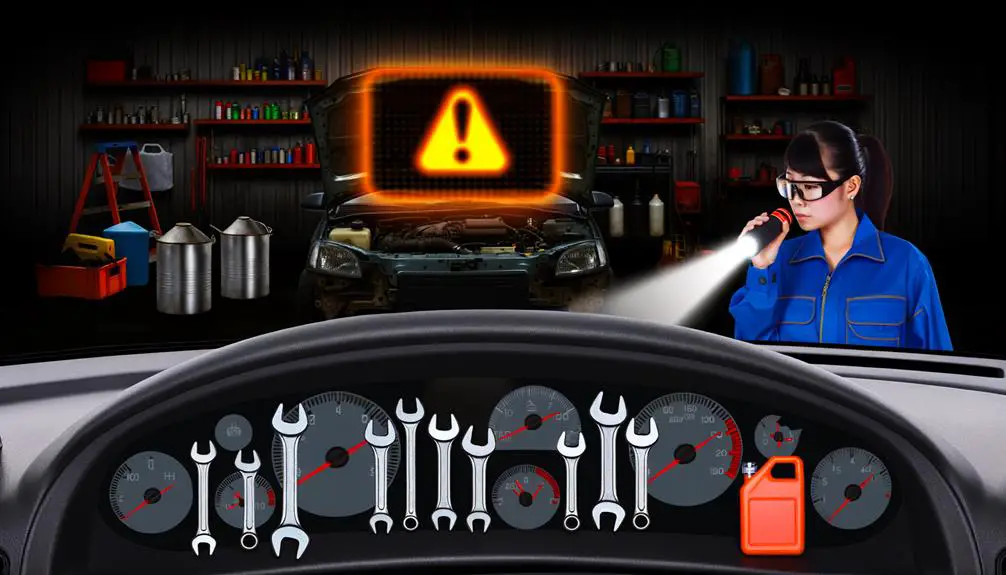
Regular upkeep and timely inspections are essential preventative measures to guarantee your vehicle's check engine light does not illuminate unexpectedly. Maintaining a proactive approach towards vehicle health can mitigate potential issues before they escalate into significant problems.
Key preventative strategies include:
- Regular Oil Changes: Ensuring oil is changed at manufacturer-recommended intervals to maintain engine lubrication and performance.
- Routine Diagnostic Scans: Periodically performing OBD-II scans to identify and address minor issues before they trigger the check engine light.
- Scheduled Maintenance: Adhering to the vehicle's maintenance schedule, including air filter replacements and spark plug checks, to avoid engine misfires and other malfunctions.
These measures, when consistently applied, enhance vehicle longevity and reliability, preventing costly repairs and unexpected breakdowns.
Conclusion
The check engine light serves as a critical indicator of underlying automotive issues, ranging from minor to severe. Understanding common causes, employing diagnostic techniques, and recognizing severity levels are essential for proper vehicle maintenance.
While some issues can be addressed through DIY fixes, professional assistance is often necessary for complex problems. Preventative measures can minimize the occurrence of such issues.
Although some may argue that immediate professional help is always required, the outlined strategies provide a balanced approach to effective vehicle management.






